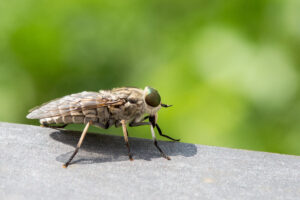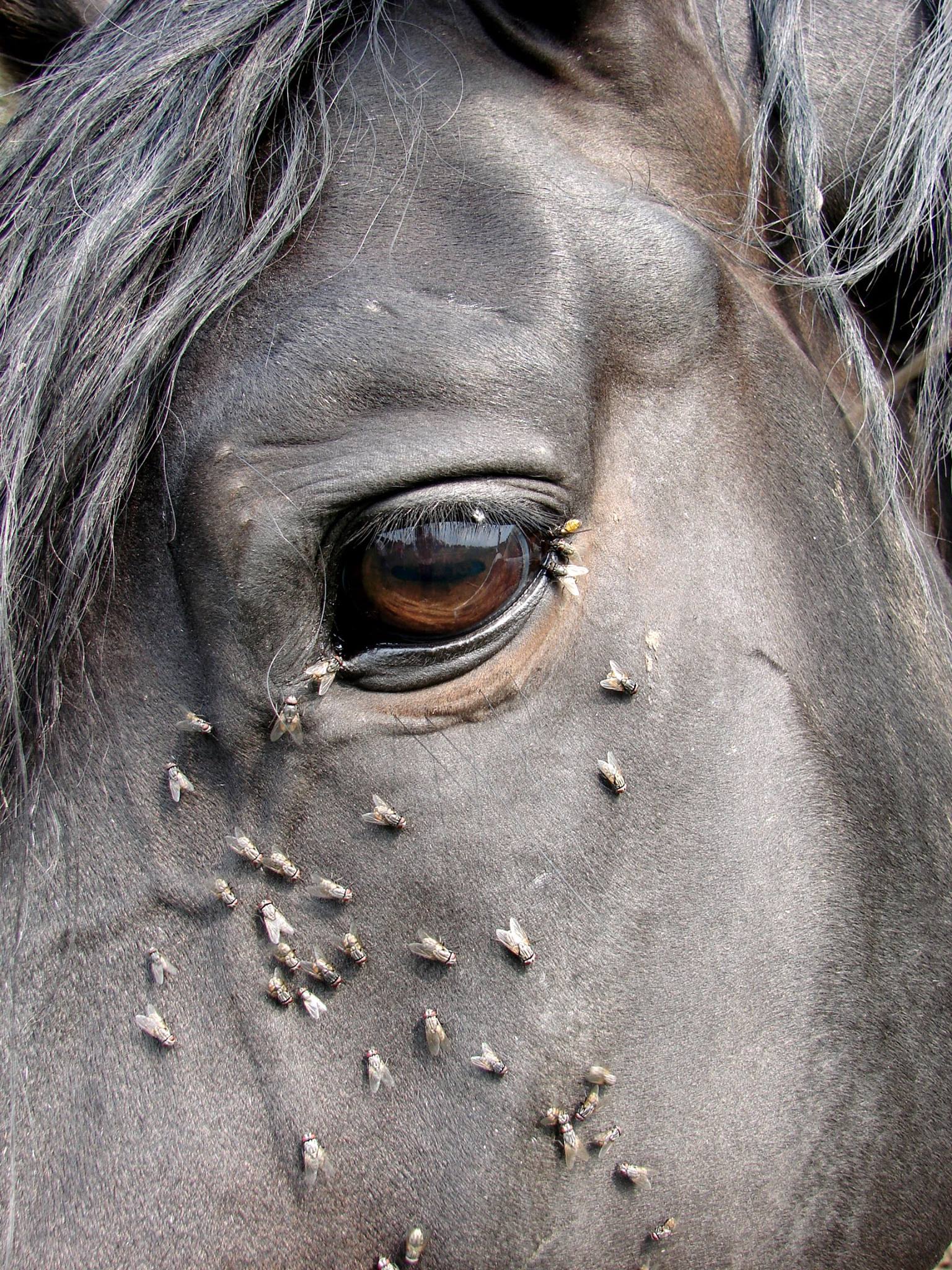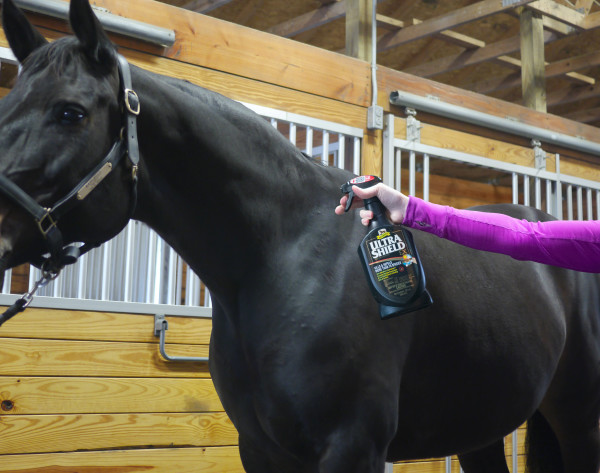Mosquito- and Fly-Borne Diseases That Can Spread to Horses
- July 24, 2024
- ⎯ UltraShield
Editor’s Note: This is adapted from an article written by Nancy S. Loving, DVM, for the spring 2019 issue of Stable Management magazine.
External pests are not just nuisances; they can bring significant health consequences to your horse. With each bite or sip of body fluid, mosquitos and flies serve as mechanical vectors to infect your horse with disease—like little syringes or sponges.
While we want to protect against as many of these diseases as possible with vaccination and good property management, horse owners also need to deter flies and mosquitoes from getting on and biting their horses.
Mosquito-Borne Equine Diseases

Mosquitoes transmit some of the most ravaging diseases throughout the world. Here are the four most common mosquito-borne viruses relevant to horses:
- Eastern equine encephalitis (EEE) generally occurs east of the Mississippi River in the Eastern United States. Culiseta melanura mosquitoes transmit it to horses, causing serious neurologic disease with 90% fatality. Horses with encephalitis appear sleepy, hence the moniker “sleeping sickness.” An infected horse develops a fever, involuntary muscle twitching and an uncoordinated (ataxic) gait. Eventually the horse goes down and is unable to get up. Most cases begin to appear in late summer on into the fall months in temperate climate regions, but cases can appear year-round in southern states.
- Western equine encephalitis (WEE), a similar neurologic disease to EEE, is transmitted by the Culex tarsalis mosquito, which lives in the western part of the USA. Fatality rate is about 40–50%. Recent years have seen a dramatic drop in equine cases, with none reported in the western United States since 2004. However, this virus is still found in birds and mosquitoes in this geographical area. Jackrabbits also can serve as a reservoir for the virus. (NOTE: For more info on EEE and WEE, click here.)
- Venezuelan equine encephalitis (VEE) causes death in 20–80% of infected horses. The bulk of the cases occur in Latin America, so there is a risk of infection in states bordering Mexico, such as south Texas, New Mexico and Arizona. While no cases of VEE have occurred in the USA in 40 years, with climate change, there could be an influx of this virus moving north out of Mexico. The primary reservoir for this virus is rodents instead of a bird reservoir for EEE and WEE.
- West Nile virus (WNV) infection does not always cause clinical signs but has a 35% fatality rate when it does. Along with fever, many horses experience problems with their cranial nerves, which are responsible for chewing, swallowing, blinking and facial muscle tone, among other functions. Infection also causes hind-limb weakness, muscle tremors, behavior changes, ataxia, an inability to stand or rise and paralysis. It is possible that other signs of encephalitis, such as seen with EEE, WEE or VEE, will develop in a horse infected with WNV: head pressing, aimless wandering, seizures, hyper-excitability and coma. About 40% of the horses that recover from clinical signs of WNV will continue to experience neurologic deficit.
Protecting Your Horse From Mosquito-Borne Diseases
There are a number of ways to protect your horse from biting mosquitoes and the diseases they can transmit. Here are the basics:
- Vaccination: The most common mosquito-borne equine diseases are effectively prevented with annual vaccination. Horses that have been vaccinated in past years will need an annual booster shot; in more temperate regions/areas with a prolonged mosquito season, veterinarians might recommend two boosters per year—one in the spring and one in the fall. Start by researching core vaccines and then develop your vaccination schedule.
- Repellents: Another effective way to combat mosquitoes is with repellents that can be sprayed either directly on the horse or around the stable and/or paddock. Many formulations exist. For example, Absorbine’s UltraShield® range includes the broad-spectrum, five-ingredient Red Insecticide & Repellent; the eco-safe Green Natural Fly Repellent; the humidity and sweat-resistant Sport Insecticide & Repellent; the multi-species Flys-X For Livestock; and the advanced formula UltraShield EX Insecticide & Repellent, which contains sunscreens, is weatherproof up to 17 days and can also double as a premise spray.

- Eliminate standing water around your barn: Whether it’s a kiddie pool, gutters, flower pots or pet bowls, dump sources of standing water as often as you can to eradicate potential mosquito breeding grounds around your property. Fill in swales that collect rainwater, and empty and clean stock tanks or troughs frequently.
- Fly sheets, masks and boots: Use barrier garments on your horse’s head, legs and body for another lightweight layer of protection. Remember to check these garments daily and remove the mask at night if your horse is turned out.
- Stable/avoid turning your horse out at dusk and dawn: These are the times when mosquitoes are most active, so keeping them indoors makes good sense.
Fly-Borne Equine Diseases
There are a number of critical equine diseases that are carried by flies to horses. Here are the most important ones in North America:

- Equine infectious anemia (EIA), or “swamp fever,” is a highly fatal viral disease that is transmitted through bites from horse flies or deer flies. Flies that are interrupted during a blood meal by swishing tails or other movement can transfer virus between horses. EIA also can be transmitted by exposure to contaminated blood products or reuse of instruments such as syringes, needles intravenous tubing and tattoo equipment without appropriate sterilization. Those that survive the acute phase become chronic, inapparent carriers. The virus causes recurrent fever, lethargy, poor appetite, low platelet numbers and anemia. The big concern is with inapparent carriers; they appear normal but are infected with the EIA virus. Flies (or equipment) can transmit virus from this seemingly normal individual to a naive horse. Routine testing with a Coggins (or ELISA) test helps to control outbreaks. A negative EIA test should be done annually for traveling or show horses—every six months is required by some states—and before a new horse enters a property and the herd.
- Vesicular stomatitis (VSV) is transmitted by insect vectors such as black flies, sand flies and midges, but the virus also can be transmitted between horses by direct contact with infective blisters, water, buckets, contaminated feed or fomites (such as hands, equipment, clothing and shoes). An infected horse develops blisters, usually in and around the mouth. There is sufficient discomfort that an infected horse doesn’t want to eat; saliva drools from the mouth as the horse is reluctant to swallow. There is usually a fever, and lesions also can develop around the nose, coronary band, sheath or udder in some horses. No preventive vaccine is available, and there is no specific treatment other than supportive care and anti-inflammatory medication. This is a reportable disease and the affected property will be quarantined until a period of time after the last case on that farm recovers. Vesicular stomatitis is also transmissible to humans.
- Sweet itch, also known as Queensland’s itch or Insect Bite Hypersensitivity (IBH), is caused by the Culicoides midge (“no-see-um”) and is an allergic hypersensitivity to the gnat’s saliva. The midges feed on the horse’s belly, but the midge bites create a systemic allergic reaction. The horse mutilates itself by rubbing on anything in reach in order to pacify the intense itch. He’ll rub off his mane and tail, and often the horse’s rump, face and chest are raw and bleeding from all of the rubbing. In some cases, there is concurrent airway disease. A new vaccine against IBH is currently being evaluated.
- Black fly dermatitis comes from black flies (Simulium spp.) that feed on the inside of horses’ ears and along the neck, chest and belly. Horses can develop an allergic reaction to the saliva from these bites, resulting in wheals (hives) and itching. Bleeding and crusting lesions within the ears cause discomfort and might develop into aural plaques. Some horses become headshy after an inflammatory reaction to black fly bites in their ears. Baby oil or roll-on insecticides serve as repellents, as do fly masks with ear covers.
- Onchocerca starts with biting midges (Culicoides) or black flies (Simulium spp.), intermediate hosts that can infect a horse with Onchocerca cervicalis. These are thread-like filarial worms that migrate beneath the skin or within the eye. The immature forms are located on the abdomen, with the adults present along the nuchal ligament of the neck. The result is inflammation and dermatitis—crusting, scales, ulcers, hair loss, and/or pigmentation loss—of the neck, chest, withers, forelegs or abdomen. Uveitis of the eye can develop, often as a reaction to dead or dying microfilaria. Ivermectin is effective at killing Onchocerca microfilaria.
- Horn fly irritation can occur when horses are pastured with or close to cattle. These flies like to feed on the shoulders, neck, withers and belly, contributing to abdominal midline dermatitis. Insecticide repellents are effective in reducing irritation caused by these pests.
- Pigeon fever (Corynebacteria pseudotuberculosis) can be spread to horses by house flies, stable flies and horn flies, particularly if landing on open sores or injecting the bacteria from fly mouthpieces with a bite. Infection results in external and/or internal abscesses and/or ulcerative lymphangitis (which results in infection and swelling of the limbs). Abscesses on the chest swell and appear like a pigeon’s breast, hence the common moniker of “pigeon fever.”
- Potomac horse fever (PHF or equine neorickettsiosis) is caused by bacteria Neorickettsia risticii. Although originally localized along the Potomac River in Maryland and Virginia, it has occurred in 44 states in areas with fresh-water streams and rivers. It generally is seen seasonally in warm months (i.e., spring, summer and autumn). Clinical signs generally include a horse with severe, pipe-stream diarrhea and colic. About 30% of affected horses die due to subsequent development of severe laminitis. Caddis fly and other aquatic insect larvae serve as natural vectors as they pick up snail cercaria containing the infective bacteria. As the aquatic insects hatch and emerge from a creek, river or ditch water, the horse incidentally ingests them in contaminated water, hay and pasture. Even stabled horses can become infected, since aquatic insects are drawn to lights at night.
- Habronemiasis, or “summer sores,” can be caused by biting stable flies and house flies that feed on wounds or chronically moist skin, infecting the tissue with Habronema or Draschia worms. These worms like to reside in the horse’s stomach, passing eggs and larvae into the feces. Once in the feces, the worms are ingested by flies to deposit the larvae on a horse’s mucous membranes, around the eyes or in wounds. The result is a hypersensitivity reaction to the worm larvae—wounds won’t heal but instead proliferate with excessive amounts of granulation tissue. Treatment with ivermectin or moxidectin kills off Habronema spp. almost 100% of the time and is effective for prevention. Using repellents and fly barriers (i.e., masks, sheets and wound bandages) is important in protecting horses.
- Rain scald/equine granular dermatitis/phycomycosis can be triggered by biting stable flies and house flies carrying fungi into wounds. This causes ulcerated skin lesions that give the appearance of skin scalding or burns. This fungal infection tends to occur in moist climates with extended periods of warm weather, such as that found in the southeastern United States.
- Bot fly larvae become a problem after stingless bot flies lay their eggs, called nits, on a horse’s legs, mane, shoulders, flanks, neck, below the jaw or on the muzzle. As the horse rubs or grooms its legs or other areas of its body, the sticky nits find their way to the horse’s mouth, where they burrow into the tongue and gums. Once hatched, the larvae are swallowed into the stomach, where they remain for seven to 10 months until they pass through the digestive tract and are eliminated in the manure to start the cycle anew. It is when bot fly larvae occur in large numbers that they can interfere with nutritional absorption and/or create stomach ulcers. Avermectin (ivermectin or moxidectin) deworming medications are effective at killing bot larvae.
- Eye parasites (thelaziasis) develop from face flies feeding on eye secretions. Thelazia parasites can burrow into the eye tissues to cause nodular reactions, or the horse might develop chronic conjunctivitis with persistent ocular discharge, corneal inflammation and/or ulcers as a result of this parasite.

- Warbles is usually seen when horses cohabit pastures with cattle. Warble flies (Hypoderma spp.) lay their eggs on the hair of the legs and belly of a horse. Once hatched, the larvae then bore inward and migrate through connective tissue toward the epidural fat of the spine or into the esophagus. In the springtime, they move to the subcutaneous back tissues to form a stationary nodule with an “air hole” that allows the larva to breathe.
- Equine sarcoids are, in some cases, caused by bovine papillomavirus. Insect vectors such as stable flies are believed to spread this virus, which is attached to the fly’s mouthpiece and can be inoculated into a horse’s skin with a bite.
- African horsesickness (AHS) is a serious and highly fatal disease transmitted by Culicoides spp. flies. Fortunately, there are no natural cases of this in the United States, but the disease is moving into other areas around the world.
Protecting Your Horse From Fly-Borne Diseases
- Manure management: A good fly control program always begins with manure management on the barn and farm. That means frequent pickup of manure in the stalls, barn aisles and out in the paddocks and fields, as well as the covering of temporary manure storage piles and regular removal of larger manure piles from the property.
- Fly predators/parasites: Another natural method of fly control is the use of fly predators, beneficial bugs that are released in the cocoon stage early in the season around areas where manure accumulates. Once mature, they kill immature flies without causing any harm to humans or horses
- Fly traps & tapes: It doesn’t hurt to add sticky fly tape and various types of traps to your anti-pest arsenal. Remember to locate traps around the outside of the barn rather than inside it, to avoid luring flies where you don’t want them.
- Feed-through products: These contain insect growth regulators that inhibit the larval development of adult house flies and stable flies when consistently added to your horse’s feed. Basically, manure deposited by a treated horse already contains the fly control.

- Repellents: As mentioned above, sprays that repel or knock down flying pests come in many strengths and varieties, including these examples from Absorbine.
- Fly sheets, masks and boots: Here again, these are worth adding to your pest control program to keep both mosquitoes and flies from irritating and biting your horse, especially out in the field or paddock. An example of one type of mask can be found here.
- Fans: Last but not least, industrial fans can be placed at one or both ends of the barn aisle to promote additional airflow, which will deter flying pests through the entire barn. Fans may also be placed in the window of a run-in shed or on the window screens of individual stalls for extra airflow.
Summary
There are many disease risks from the vast array of insects that cohabit a horse’s environment. Insect control strategies, immunization against infectious disease when possible, and diligent attention to management details are important control strategies, along with regular monitoring and scrutiny for anything amiss with your horse.





